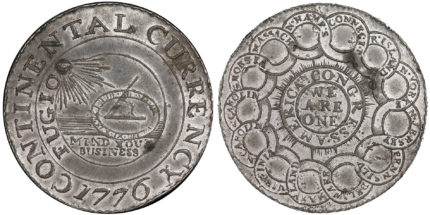A 50 cent flea market find has been certified as a rare 1776 pewter Continental Currency dollar valued at $97,500. The buyer spotted it in a junk box full of assorted coins at a market in Northern France in June 2018. He was curious about this unusual American piece and agreed to shell out half a euro (56 American cents). He Googled it, took it to a local coin dealer who didn’t know what it was and recommend he ship it to the US for expert assessment. The Paris office of the Professional Coin Grading Service was easier to get to and well-versed in the ways of this very rare, never-circulated issue.
This coin was proposed by the Continental Congress for nationwide issuance. Pattern pieces — trial strikes of a new design for a coin — were struck in pewter, brass and silver. Mysteriously, even though most of the extant coins are pewter, there is no known documentation surviving of the pewter issues being authorized by Continental Congress. This particular die variety, known as Newman 2-C, has only ever been found in pewter. If silver or brass versions were struck, they have yet to be revealed.
1776 Continental Dollars feature an obverse of three rings. The center ring design is a sundial, with the rays of the sun and text below the dial, “MIND YOUR BUSINESS.” The next ring features “FUGIO” and the sun. The last ring contains the text, “CONTINENTAL CURRENCY.” The reverse features a design of interlocking chain links around the border of the face, featuring the names of the 13 colonial states. The reverse design contains two rings, the center of two rings reads “WE ARE ONE” and the ring around the center ring reads “AMERICAN CONGRESS.” The coins have several varieties in the spelling, ornamental designs, or in metal compositions. While produced in a variety of metals, the coin was most often struck in pewter.
The intent of the Continental Dollar was originally believed to be pattern or circulation issue coinage for the continental United States to circulate alongside the banknotes that Congress had authorized and issued. However, in recent years others have argued that the coins were actually medals, made as satire by England – struck in pewter to mock the worthless value of the currency of the United States. While the origin of these pieces is still under debate, the 1776 Continental Dollars are important early coinage celebrating the birth of the brand-new nation of the United States. This iconic coin has been heavily counterfeited and many restrikes have been produced privately. Even these private restrikes have gained popularity due to the scarcity of original examples and are now being actively collected.
Both obverse and reverse were designed by Benjamin Franklin. The inscriptions and iconography on the obverse were meant to be read as a rebus. Fugio, meaning “I flee” in Latin, connects to the sun which casts shadow on the sundial. “Mind your business” didn’t mean what it means now. It’s literal, as in “see to your business interests.” All together, the obverse advises that time is fleeting, so mind your business. The reverse is an appeal for unity among states rendered as a linked chain.
Unable to secure anything like the amount of silver necessary for coinage issue, the Continental Currency coin never was circulated. They went with paper money instead, and it was an unmitigated disaster of devaluation and counterfeiting. Time, while fleeting, heals all wounds, however, and one of four known silver issues of the pattern piece sold at auction for $1,410,000 six years ago.
The first official circulation coin of the newly independent United States would be this coin’s fraternal twin. The Fugio or Franklin cent was struck in copper and minted in 1787. The “Fugio,” sun, sundial and “Mind your business” were on the obverse, the loops representing the 13 states (not labeled) interlinked around “We are one” on the reverse. It was only issued that one year. After the ratification of the Constitution in 1788, the triple motto was replaced with the one on the Great Seal of the United States, E pluribus unum.
